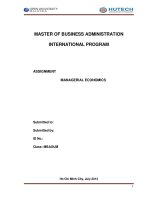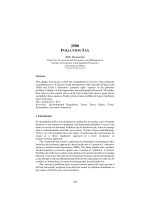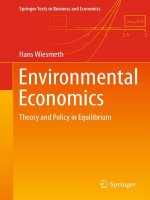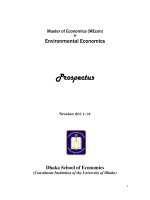environmental economics assignment
Bạn đang xem bản rút gọn của tài liệu. Xem và tải ngay bản đầy đủ của tài liệu tại đây (68.07 KB, 6 trang )
ENVIRONMENTAL
ECONOMICS
Econ 240
Prof: Dr. Stephan Kroll
s t u d e n t s
Nguyen Nguyen Huong - 1213140039
Pham T. Thu Huong - 1217140073
Hanoi, 2014
WRITIN
G
ASSIGNMEN
T
Econ 240 WRITINGASSIGNMENT
page 5
hile the economies in developing countries thrive rapidly in the last few
decades, pollution problems also rise as a severe consequence of this
development. Particularly in Vietnam, the water pollution of Saigon River has
reached an alarming rate, affecting the lives of hundreds. This highly concerned issue was
illustrated in the article Vietnam's Saigon River poisoned to death
(*)
. On the basis of this
article, we will briefly discuss the pollution of Saigon River and suggest several policies to
tackle this issue.
W
Saigon River, situated in a densely populated area in the South of Vietnam, is the
main water supply source for Ho Chi Minh City and the vital waterway for trade and
commerce in this area. According to the article, it is severely contaminated by wastewater
from a variety of sources, including households, small production facilities, animal farms,
hospitals and industrial parks. The majority of this wastewater is not properly treated by
treatment systems or the city’s treatment plant (1.2 millions cubic meters out of over 1.3
millions). The river’s water failed to meet national quality standards and experts proposed
that urgent steps have to be taken to revamp the situation.
In economics terms, the river is a public good because it is non-excludable (everyone
has access to it) and non-rival (if one household uses it, others can as well). When a public
good’s quality goes down, everyone suffers. In fact, this particular public good is severely
damaged by many parties in society and in turn the contamination hurts not only the
polluters but also other local people. Factories located along the river only consider their
private costs when deciding how much to produce, ignoring the fact that other real costs
should be taken into consideration. Their wastewater makes the water quality go down,
which harms local water users, fishers, mariners and forces the authority to engage in more
costly treatment processes. From the firms’ standpoint, these are external costs. The
external costs together with the private costs make the true cost of emission, or the social
costs.
People directly pump wastewater into the river for a number of reasons. For
households, the city’s collection and treatment of domestic wastewater is inadequate
(wastewater treatment plant’s capability cannot keep up with the emission level) and
families themselves cannot afford the treatment equipment nor find any reason to buy
them. They are also incapable of finding alternative ways to dispose wastewater, so pouring
it into the river might be the only way. In addition, households assume their wastewater
will have little damage on the river, as the quantity of each family’s wastewater is small.
Firms, on the contrary, have the central treatment systems available but they still emit
Econ 240 WRITINGASSIGNMENT
page 5
untreated waste on Saigon River. This may due to the incentive to save resources: time,
money to operate the treatment system, equipment depreciation and human resources. It is
much less costly for them to simply pump untreated wastewater into the river.
Among the policies introduced in Econ 240, some apply concordantly to Saigon River
case and some do not as will be discussed below. Firstly, the city should set technological
standards for firms’ treatment systems and require firms to have their wastewater treated
properly before pumping into the river. This upgrade in technology will shift the firms’
marginal abatement cost curve downwards, thus give them the incentive to decrease
emission. This mandatory policy is necessary in areas where people’s awareness about the
environment is relatively low. Secondly, information programs should be implemented to
raise residents’ awareness about the environmental issue they are facing. Local authority
should disclose the emission level of local firms and the pollution level caused by residents
themselves. Information about hazardous harms and diseases that come from water
pollution should also be included. Since not many residents in this area have access to the
Internet, local message boards and daily radios would be the more effective ways to convey
useful information. Once they realize the harms of pollution on their own lives, residents is
more likely to cut down on wastewater and have community pressure on firms to do the
same. Thirdly, the authority can set (green) tax on each unit of emission firms emitted into
the river. The advantage of this policy is the efficient results of emission tax are achievable
even when the authority does not know about firms’ marginal abatement costs. There are
lots of firms along Saigon River with different sizes and types of products, so their
individual marginal abatement cost is difficult to measure by the authority. An emission tax
system allows the authority to avoid this problem and is relatively simple to apply and
enforce. For households, a charge per capita should be implemented based on the emission
level of domestic wastewater.
Aside the policies listed above, there exist other policies that are not appropriate to
improve Saigon river situation either. Firstly, in “Command and Control” approach, setting
the emission standards might not seem to work since contributors to pollution are complex
and varied, including not only firms and factories but also health centers, small production
facilities and households, whose domestic wastewater making up 62.2 percent of total. For
that reason, it is not easy to calculate the abatement cost to set an appropriate emission
standard. Secondly, according to “Voluntary Actions” policies, private negotiation is not a
good choice either as this situation in Saigon River doesn’t satisfy the policy’s condition:
too many parties included, high transaction cost as well as incomplete set of market. Under
the same approach, moral suasion will be unsuitable because not all are equally
Econ 240 WRITINGASSIGNMENT
page 5
responsible from an ethical standpoint, some people will respond to moral argument while
others will become free riders. Thirdly, in “Incentive-based” policies, tradable permit,
deposit-refund and liability rules are all inappropriate to the problem of Saigon Rivers
owing to the following reasons. Tradable permit is unfamiliar and seems to be impractical
in Vietnam society and also Vietnamese legislators. Even if tradable permit can be applied
in this case, it will still not work effectively as more than 60 percent of the amount of
pollutants comes from residents of various sizes and forms, which using this policy might
cause enormous difficulty and complexity. Also, Deposit-refund system is mostly imposed
on recyclable and easily transportable objects such as can, bottle, and box… so it will
present a hassle for people and firms wanting to collect and bring wastewater back for a
refund. And for liability rules, this policy is usually applied to the cases of accidents, in
which the aforementioned situation concerns continuous pollutants.
Regarding the three policies that are applicable as analyzed above, people will
change their behaviors differently according to each policy. Firstly, if an information
program were to be implemented, nearby residents would reduce their emission as they
realize the impact of their behaviors. Aside from that, their reaction toward firms
continuously causing pollution would be condemnation and boycotting until a reduction in
the level of pollution occurs. As for firms and factories, under the community pressure they
will voluntarily reduce the emission level to the point that will lessen the tension. A very
close example of this is the case of Vedan Company emitting a large amount of wastewater
into Thi Vai River. After facing a widespread condemnation, the company was forced to
compensate money and significantly reduce their pollutants
(**).
Secondly, once technology
standards come into play, firms and factories will follow the rule to optimize their existing
treatment and implement new technology to reduce emission, otherwise they will be fined
as the policy got put into effect. The city also has to upgrade its wastewater treatment
plant to increase capability to meet the huge demand. Lastly, if green tax policy is
implemented, firms will reduce their emission to the level where the tax curve intersects
with the marginal abatement curve to reduce total cost. As for nearby residents, tax
charged per average domestic pollutant would give them the incentive to reduce domestic
wastewater.
The information program is both feasible and acceptable because it does not require
much political resources. And since clean water is a public good, all people will benefit
from a better environment. However, those who have to spend money, time and other
resources – which are, in this case, firms and factories - to cut down on emission owing to
community pressure will lose from this. Secondly, as for technology standards policy, this
Econ 240 WRITINGASSIGNMENT
page 5
might be acceptable thanks to its effectiveness but probably not feasible owing to low
budget of firms as well as of the government. For the same reason as information program,
all people will receive benefit from a clean river. But firms and government will lose a
significant amount of resources to collecting information so as to set the standards and to
enforce the quality. Moreover, a great amount of money will have to be spent on investing
and upgrading treatment plant to meet the demanded capability. In contrast, green tax is a
more feasible policy because it is more conventional and easier to carry out. However,
green tax might be unacceptable due to disapproval of residents as a result of inequity:
some households emitting less wastewater than others yet still have to pay the same
proportional tax. Besides that, most of the people living along Saigon River have low income
so they may suffer from green tax policy.
In conclusion, all the policies listed above have their own advantages as well as
disadvantages. None of them is exclusively perfect for the case of Saigon River in Vietnam.
So for that reason, policy makers should fully analyze the situation and flexibly incorporate
all the suggested policies to reach an optimum solution.
Econ 240 WRITINGASSIGNMENT
page 5
R e f e r e n c e s
(*) www.thanhniennews.com: “Vietnam's Saigon River poisoned to death”
Last updated: Thursday, November 28, 2013 11:00
death.aspx
(**) www.thanhniennews.com: “Boycott fear forces river polluter payout”
Last updated: Friday, August 13, 2010 10:35
www.abc.net.au: “Firm pays up after pollution destroyed river”
Last updated: Thursday, August 12, 2010 11:05









